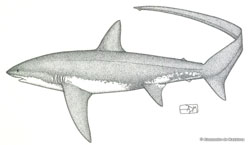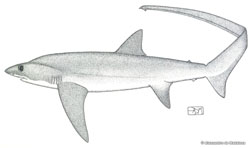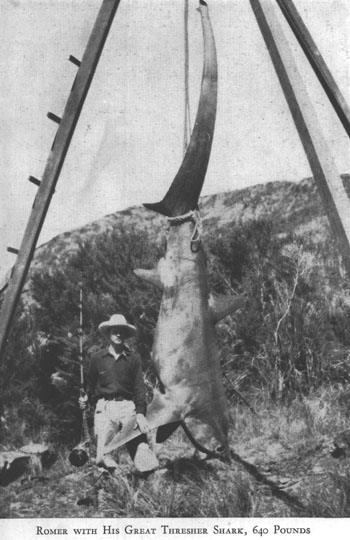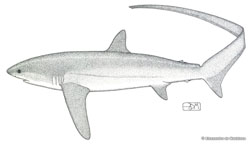|
Thresher sharks are easily recognized by their enormously long caudal fins, comprising half of the total body length. There are two species seen here in the Monterey Bay, The Big eye thresher (Alopias superciliosus) and the common thresher (Alopias vulpinus). The Big eye thresher can be distinguished by its enormous, upward-looking eyes, which are much larger than those of the common thresher and are as highly developed an optical system as nature has produced outside of the larger Cephalopods. Their huge eyes are developed for deep water dark and night vision capabilities. Big eye threshers apparently have deep water capabilities but are not a well studied animal.
|

Common thresher, (Alopias vulpinas) common off California coast and Monterey bay.
|

Big eye thresher shark (Alopias superciliosus),common in deeper offshore waters of the pacific basing including deep waters of Monterey Bay and associated marine canyon.
|
From the early stages of development threshers apparently feed mainly on small schooling fishes and squid, which they manipulate, corral and stun with strikes from their long, whip-like tails. The teeth are relatively small but razor sharp, with curved, smooth-edged cusps, and are similar in both jaws specialized for seizing individual prey items. As they grow into the heavier classes and stages of maturity they target even large tunas and are not as relegated to schooling fishes and bait fish. As a deeper water specialist the big eye thresher is a keen predator of some of the larger squids. Some specimens have been discovered with sea bird remains in their stomach content. The big eye may be a nocturnal specialist in addition to having the deep water capabilities.
Exceptional specimens of both species may reach 20 ft. and over 1,000 pounds.
There is a third species of thresher shark that is as yet not known to occur in Monterey bay called the
pelagic thresher, (Alopias pelagicus) this shark occurs in the tropical to subtropical Indo-Pacific. Pelagic thresher are understood
to reach at least 10 feet in length.
Common threshers vary in color from coppery-brown to bronze color above, with metallic blue and purple hues. The undersides are white.
Big eye threshers are dark brown to metallic purple or even black in color with paler dusky ventral surface. The pelagic thresher of the indo pacific appears similar but with slightly lighter colorations.
All three species have very fine scales and the denticulated hide is easily scuffed during landings and strandings, researchers must take special care when handling these elegant and somewhat delicate species of sharks.
Clickable:
The tail tips of common thresher sharks of the eastern pacific coast appear to uniformly have a left tilting tail tip that forms a small cup like form above the caudal’s terminal notch.

All three species of thresher are believed to reproduce via ovoviviparity whereby the embryo is nourished via yolk sac; as the shark pups develop and eventually exhaust their yolk; the unborn thresher sharks feed on ovulated eggs, a process termed oophagy. The gestation period is unknown but new born pups have been measured at approximately 5 feet total length. Males are believed to reach maturity at 10 to 15 years of age, while females reach maturity even later. All three species are poorly understood, especially the pelagic thresher and the big eye thresher. These sharks are presumed to live at least 20 years or more.
They are currently being exploited by the commercial and sport fishing industry and has been classified as vulnerable by the International Union for Conservation of Nature (IUCN) since 2007.
The meat is considered to be very good table-fare and has become increasingly pressured by directed and incidental commercial take as well as a growing interest in this species as a sport and big game target for recreational anglers. There are very few images of live, free swimming big eye thresher sharks and it has become a prized species among upper tier wildlife and underwater photographers.

Pelagic thresher shark, (Alopias pelagicus), this shark occurs on both sides of the pacific basin, including southern California however but has not yet been documented in Monterey bay.
| 